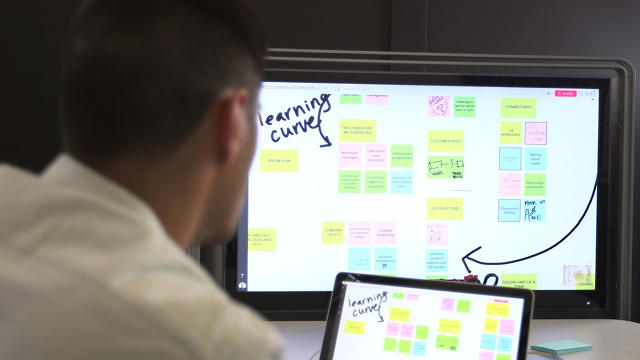International design firm Ideo popularized the designer brainstorming session: Just lock a team of creatives up in a conference room with some Sharpies and multi-colored Post-its, and don't let them leave until a brilliant idea strikes. But this brainstorming method doesn't work well when your team is spread around the globe. Now Mural, an alumni of Ideo's startup-in-residence program, is trying to bring what goes on inside Ideo's conference rooms to the cloud.
The core idea of Ideo's brainstorming sessions is to externalize everything. Like a paint gun fight, you want to spatter the whiteboard with as much color as possible, filling stickies with ideas, random thoughts, doodles, inspirations, slogans, questions, and more. The refinement comes later, organizing the ideas, figuring out which ones to pursue, and refining them. The end point of a brainstorming session is totally arbitrary: it might be when there are 30 ideas on the wall, or it might be when there are 3,000. It's a messy process that is inherently physical, involving lots of jumping up, feverish scribbling, and even yelling.
Mural brings this practice online, allowing team members to brainstorm from anywhere. It's used by companies and organizations ranging from IBM to Stanford's business school. Each Mural project is an unbounded whiteboard that can grow and shrink to any size, depending on how much it contains. As usual, brainstorming is done by flinging stickies at this whiteboard, but the stickies don't have to be just text or a drawing. They can also be web links, file documents, YouTube videos, MP3, PDFs, photos, and so on. Once a stickie is on a Mural, it can be edited, rearranged, customized with different colors and text, moved elsewhere on the board, or commented on. Any number of team members can join a Mural, and work on it at the same time, whether they're working together in an office, or dialing in from halfway around the world through their iPhones or iPads. Mural runs on Microsoft's giant 84-inch Surface Hub interactive touchscreen, so you could theoretically replace your conference room whiteboard with one running the software.
According to Mural cofounder and CEO Mariano Suarez-Battan, one of the things he wanted to accomplish with Mural was to re-create the "magic that happens" in real-world brainstorming sessions. At his last company, the Argentinian social gaming company Three Melons, Suarez-Battan would often brainstorm ideas with whiteboards and stickies when coming up with new game characters of types. When online social gaming platform Playdom acquired his company (four months before being acquired by Disney itself), Suarez-Battan found himself trying to get his new corporate overlords involved on brainstorming sessions. But he couldn't just take a photo of Three Melons's brainstorms and present them to Playdom as part of a slide deck. "The medium changed how these ideas were evaluated," he says. "Instead of getting them involved, we were being judged by the roughness of our ideas."

Those familiar with Ideo-style brainstorming know that this sort of third-party judgment is totally antithetical to the process. But what else could be expected? Brainstorming works because everyone is in it together from the beginning. A team of executives 1,000 miles away can't just jump into a brainstorm mid-stream, unless they can somehow take part in it from where they are. Suarez-Battan had his eureka moment, and when he left Three Melons, he started Mural to make it a reality. Trying to get Mural off the ground, the new company hooked up with Ideo almost by accident, but Suarez-Battan said the collaboration made perfect sense: "After all, they were our ideal client."
Today, an alumni of Ideo's startup-in-residence program, Mural has over 35,000 monthly registered users. More than half of those users come from IBM, Mural's biggest customer, with other clients including Suarez-Battan's ex-bosses at Disney, Steelcase, and educational institutions like the California College of Arts and Stanford Graduate School of Business. With pricing starting at $300 a year for a team of five members, it fits squarely in the camp of enterprise-facing products.
Mural certainly isn't the only workplace collaboration tool on the planet. Tools such as Slack and Trello similarly allow teams to brainstorm, no matter where they are, and have more brand equity. To Suarez-Battan, Mural distinguishes itself by capturing the chaotic physicality of brainstorming. Slack, Trello, and other apps are ultimately about trying to clean up the chaos of collaboration; Mural embraces it. When brainstorming works best, teams are literally spattering the walls with their ideas. Mural just wants to digitize that wall.
Sign up for a free trial here.